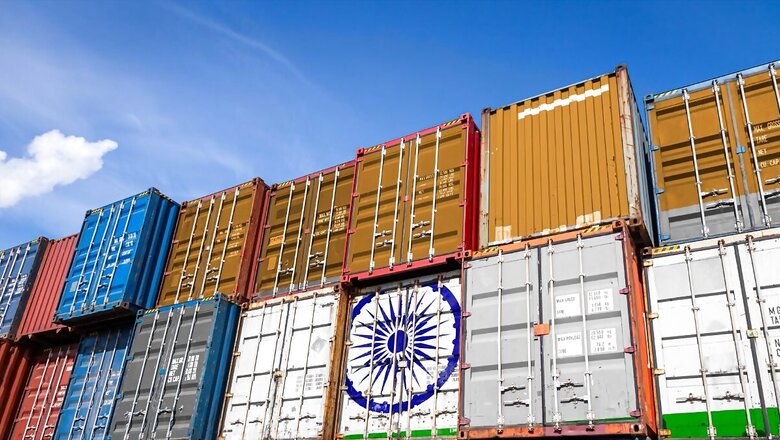
views
The world is practically on fire. If the war in Ukraine had not wreaked enough havoc on global supply chains, the conflict in West Asia and the resultant impact on Red Sea shipping lanes is adversely affecting the trade calculations of a host of countries. India is not particularly insulated to the crisis, and yet, it is persevering rather remarkably.
India’s exports rose to a three-month high of 3.12% to $36.92 billion in January, despite global uncertainties, including the Red Sea crisis, while the trade deficit narrowed to a nine-month low of $17.49 billion. However, that is not the story we want to focus on.
2023 was an important year for India. As the country seeks to become a manufacturing and export hub and offer the biggest alternative to China, it was able to successfully diversify its export markets and enter previously untouched territories. That is the story we will focus on.
According to an analysis by the Commerce Ministry, India’s exports of goods like automobiles and gold jewellery have ventured into uncharted territories of Central Asia, Africa, Europe and Latin America. India last year managed to penetrate into “absolutely new markets”. These are regions where it did not see any export during April-December 2022.
Cut to the same period in 2023, and India’s exports of certain principal commodities such as motor vehicles, two- and three-wheelers, petroleum products, sugar, gold and other precious jewellery recorded a significant rise. Exports of these commodities to the “absolutely new markets” during April-December 2023 stood at $234 million as against nil shipments during the same period of 2022.
According to an official, “A comprehensive examination of country-wise exports underscores a notable diversification of markets for India’s merchandise exports, characterised by the exploration of new export destinations, in spite of strong global headwinds with subdued performance globally.”
Expansion of exports and diversification into newer markets are the two broad themes India appears to be pursuing in its trade policy. Together, exports to these markets capture 5% of India’s total exports of 42 principal commodities to the world. These commodities span across 16 important sectors of India’s export basket, the official added.
In these fresh markets, where exports were previously minimal or non-existent, India’s share of certain items surged to $2.17 billion during April-December 2023. The items include ceramics and related products, aluminium and its products, two- and three-wheeled vehicles, iron and steel products, electric machinery, and equipment.
The Ministry’s analysis has also revealed that the export of two- and three-wheelers has penetrated 31 new markets or countries, amounting to a total exported value of $110 million during the April-December 2023 period. Likewise, in the “promising markets” encompassing North and South America, Europe and Africa, where the country’s outbound shipments of these goods previously accounted for less than 1%, India’s export volume surged to $8.6 billion during the first nine months of this fiscal year.
India’s entry in the Nordic-Baltic region in Europe is particularly noteworthy. Over the past five years, India’s exports in this part of the world have increased by over 39%. Exports to Finland and Norway alone have grown by over 100% and 80% respectively.
Similarly, India’s exports to Australia saw a 14% year-on-year jump to $5.87 billion in the first eight months of current financial year (April-November FY24) on the back of the two countries signing what is largely seen as a favourable free trade agreement (FTA).
Also, between January to July in 2023, at least 48 commodities saw significant increase in exports. These include moulding machineries, beverages, cereals, fruits, vegetables, drugs & pharmaceuticals, leather, marine products, fertilisers, iron ore, cosmetics and toiletries, and inorganic chemicals.
INDIA: A GLOBAL EXPORT HUB IN THE MAKING
India’s New Foreign Trade Policy has set an ambitious goal for 2023. By then, India wants its exports to breach the $2-trillion mark. For perspective, India exported goods and services worth $770.2 billion in 2022-23. India must target an export growth rate of about 15% if it wants to fulfil the goal of exporting $2 trillion worth of goods and services by 2030. In 2022-23, exports jumped by 11.3%, in what came as a much-needed silver lining after a decade of extremely slow export growth.
It would not be an overstatement to suggest that India is now entering its golden years in the export business. Last year, the Boston Consulting Group (BCG), a global consulting firm, revealed in its research that between 2018 and 2022, India’s exports to the US had increased by 44%, while China’s had declined by 10%.
Meanwhile, India’s monthly steel exports hit an 18-month high of 1.1 million tonne in January due to increased demand from the European Union and supportive global prices. Also, according to S&P Global Commodity Insights, India’s export of wind turbine components in 2023 nearly doubled in revenue terms compared to 2019. The growth in the solar sector is staggering. Indian solar exports rose 227% year-over-year (YoY) to $1.8 billion in 2023 from $561 million in 2022. The cumulative growth in wind and solar exports show India is successfully heading towards the direction of becoming a global manufacturing hub for renewable energy equipment.
India also plans to go big on defense exports. New Delhi now realises that real power and influence comes with a strong economy that can withstand global challenges and an equally robust military-industrial base. Speaking recently at the Firstpost Defence Summit, Defence Minister Rajnath Singh said India’s annual defence production is expected to touch a whopping Rs 3 lakh crore and exports of military hardware is poised to reach Rs 50,000 crore. Exporting defence equipment and weapons systems will place India solidly in the world’s “big boys” club.
The significance of India finding new export markets for its goods cannot be stated enough. This strategy not only reduces dependency on specific markets, but also enhances India’s competitiveness and contributes to economic development. A good example to highlight the importance of exploring new markets would be Russia, which was able to divert much of its fuel supplies to Asia despite sanctions and embargos by the West, effectively keeping the Russian economy on a strong footing.
India’s entry in new markets also marks its ascendance as a trade power that interacts with the larger global south on a priority basis, and is keen at developing trade ties with this part of the world. Exporting goods and services to a diverse basket of countries will help India cushion the impact of any and all adverse situations that a-particular country or region may be going through. That is a good strategy to have for a country that is eyeing the global superpower status for itself.















Comments
0 comment